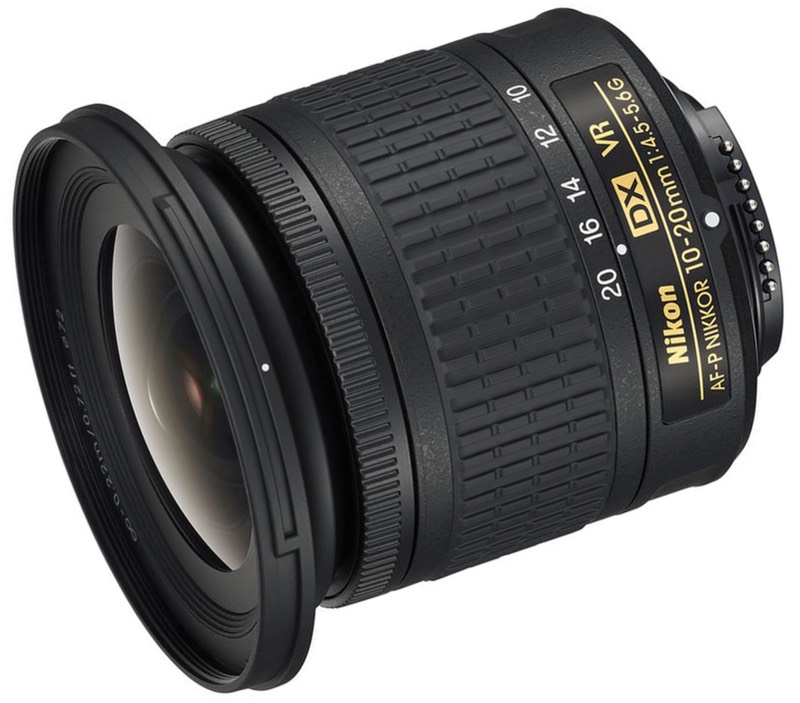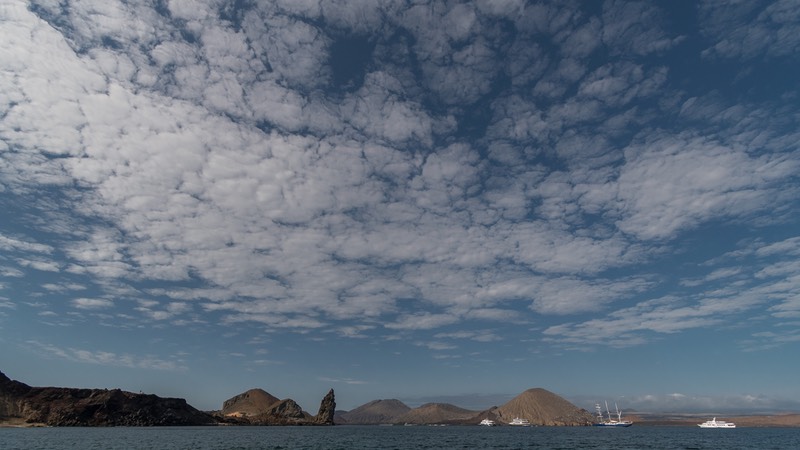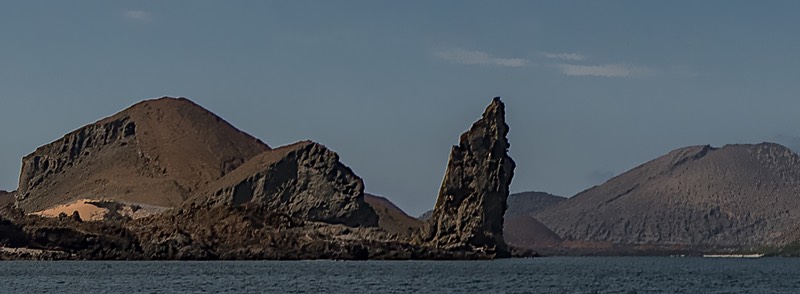
What is It?
The 10-20mm f/4.5-5.6 is Nikon's most recent wide angle zoom for the DX bodies. In full frame equivalence, it's a 14-30mm lens, so it covers the very wide to wide range.
What you'll notice first is how small and light this lens is. At 8 ounces (230g), it's not going to weigh your kit down. and at 3" in length (77mm), it doesn't take up a lot of space, either. The overall design is high in polycarbonate use, and does feel a little on the cheap side, but this is also an inexpensive lens.
Internally, we have 14 elements in 11 groups with 3 aspherical elements. Curiously, no ED elements. The prediction from that optic design would tend to be "higher in chromatic aberration, and onion skinned bokeh" (which is proven out in practice). The front filter ring is 72mm, and this moves forward as you zoom out (though it doesn't rotate with zoom or focus).
Closest focus distance is about 9" (0.22m), but since this is a very wide lens that doesn't produce a lot of magnification (maximum of 1:5.9. Maximum aperture is f/22 at 10mm, f/29 at 20mm, and the lens has a 7-blade aperture diaphragm.
VR is on by default with this lens. The following cameras have a Custom Setting menu option to turn VR on and off: D5, D500, D850, D3400, D3500, D5600, D7500. The following cameras require updates to their firmware to get that option: D3300, D5300, D5500.
This lens is AF-P in its focus positioning. That means that it is restricted to the Z6, Z7, Df, D5, D500, D750, D810, D850, D3300, D3400, D3500, D5200, D5300, D5500, D5600, D7100, D7200, and D7500 cameras to get autofocus.
So, let's put that into context. Only the bold-faced DX DSLR cameras in the following lists can use this lens and all its attributes:
- D40, D40x, D60, D3000, D3100, D3200, D3300, D3400, D3500
- D5000, D5100, D5200*, D5300, D5500, D5600
- D70, D80, D90, D7000, D7100*, D7200*, D7500
- D100, D200, D300, D300s, D500
* Indicates that VR cannot be turned on and off. It is on by default.
I put it this way so you can see what Nikon did: there's definitely a cut-off point. That point probably indicates about the time-frame that Nikon began green-lighting the AF-P lenses, and it's fairly recent. If you own one of those older non-boldfaced bodies, you're going to be slowly relegated to non-compatibility, it appears. I doubt this is a plot by Nikon to encourage you to upgrade. It's more likely that two-way 100% legacy compatibility is going to be a thing of the past as we move further and further into electronic mount communication and new technologies.
Put another way, Nikon has judged that maintaining full backwards compatibility can't be maintained. Putting old lenses on new bodies still will retain compatibility at the higher body levels, but putting new lenses on old bodies is now clearly a thing of the past. First they dropped screw-drive focus, now we have electronic apertures, logic VR control, and stepper motor focus, all of which require newer cameras to handle these newer lenses.
The lens is made in China and sells for US$310, though it is sometimes discounted from that already low price. The lens comes with an HB-81 bayonet lens hood.
Source of the reviewed lens: purchased
How's it Handle?
Not much to say. This is a small, light lens with two rings and no switches. The zoom ring is nearer the camera, wide, and easy to find. The focus ring is up front just behind the extending portion of the lens—the lens extends forward at 14mm—and a little more difficult to find because it is so thin. At least it has a distinctly different grip pattern.
How's it Perform?
Autofocus: fast and silent, as seems to be the case with all AF-P lenses. Not a lot of mass is moving inside this lens for focus, and the AF-P motor is fast. This is mostly true of Live View, as well, where you get a very quick seek-and-verify positioning on single servo focus as opposed to the slow-slide-to-place-and-verify positioning you might be used to with AF-S lenses. Continuous autofocus in Live View is more mirrorless camera like than you'd get with AF-S lenses, too.
VR: Nikon only claims 3.5 stops CIPA for stabilization, and that seems about right in my testing. This isn't as good as you find on most recent Nikkors, but it's far better than having no VR at all. VR does deal with panning on this lens, but there are no options to set such as Sport mode. Nikon equivocates on use of VR on a tripod, seemingly indicating that the lens has tripod detection. Personally, I found that I needed to turn VR off on a tripod.
Sharpness: Surprisingly good for its price. I'd call it very good overall at 10mm, just good at 20mm. So let's go through some of the details.
At 10mm, the lens performs near its best in the center at f/4.5, but stopping down to f/5.6 brings out a little better center region and you have to stop down to f/8 to bring the edges up to what I'd call very good.
The lens actually gets a little better as you zoom in some. At 12mm and even 14mm, the edges almost match the central region, though you still probably want to stop down to f/8 to get everything this lens can deliver.
20mm is the weak point of the lens, a common situation with zoom lenses (longest focal length weaker than widest). Here I'd rate the center as only good at f/5.6, and you again have to stop down to f/8 to get the best results.
The far corners of the frame don't match the edges, as usual, and are where you see a real drop-off in this lens. But again, at f/8 they're coming well into the range I'd call good—and in some cases very good—other than at 20mm, where I'd just call them fair.
Coma and astigmatism are actually better than I'd expect. Coma is well handled, though astigmatism in the corners was clearly present, particularly at the wider focal lengths.

Yes, it's wide. Very wide. And yes, it is still capable of capturing detail, despite this being near the edge of the frame, from a distance, and at f/8:

For its price, this Nikkor is clearly producing results better than many would expect. Given that a lot of the use of wide angle is for landscape photography and you'd be stopping down to get depth of field, this lens tends to hold its own against the other candidates, including Nikon's own previous 10-24mm DX offering. In many ways, this new version is just a bit more well-behaved across the board.
Linear Distortion: As you might expect, there's linear distortion. Indeed, it's probably the worst attribute of this lens when used on DX bodies. At 10mm it is over 3% barrel distortion. Curiously, the lens seems to remain with barrel distortion out through 20mm, though at that focal length the amount is ignorable (less than half percent). I didn't notice any terrible complications to the distortion. But there was a small bit of non-linearity in the distortion. The primary barreling happens out past 9mm from center. Out to that point the linearity is actually pretty good. Thus, when correcting in software I suspect you'll either still have to tolerate a bit of barrel at 10mm, or you'll get a slight pincushion on the inner area.
Vignetting: A bit lower than I would have expected, though covering more of the frame than I'm used to. The image circle of this lens is bigger than it needs to be (more on that in a moment). Vignetting is very reasonably controlled, maxing out somewhere just above one stop and half. I do note, however, that the pattern on my sample is offset slightly to the right, an indication of potential mis-centered alignment. (I wouldn't read too much into that comment; I've see a lot of Nikkors where it is just clear that "center" is designed to be off slightly, though typically more up/down than left/right. I didn't see corresponding sharpness patterns that suggest a mis-aligned lens, so I'm not concerned about this finding other than it makes vignette correction a bit more difficult.)
By f/8 vignetting is well controlled at all focal lengths and mostly ignorable.
FX bodies: on an FX body at 10mm you can see the image circle plus the lens hood notch at top/bottom at 10mm. By just beyond 14mm these are gone, though the lens is still vignetting strongly in the corners. Take the hood off and the lens is usable full frame on an FX body by about 13mm, again with strong corner vignette.
Chromatic Aberration: It's there, particularly lateral CA. You will still see lateral CA at smaller apertures as you move into the corners. Funny thing is, the CA is reasonably "constant." Stopping down helps a little, but only a little, and it helps slightly more at 20mm than at 10mm. As you might expect for a slow zoom, very little longitudinal CA is present.
Flare: I was able to produce some interesting flare pattens with this lens with in-frame highlight edges. It's possible to produce a complete ring reflection with this lens in some cases, particularly at 20mm.
But frankly, overall flare control was much better than I'd expect for a wide angle zoom. It's only in extreme cases I saw anything that would annoy me.
Final Words
At US$310, there's no hesitation on my part in recommending this lens. It just became the low-cost wide-angle zoom of choice for DX shooters.
Moreover, it's DX appropriate. By that I mean that it is small and light, while stripped a bit of features (no lens switches, focus distance scale, etc.). What hasn't been removed is basic optical performance. While it might not be the absolute best wide angle zoom you can get for DX bodies (the Tokina 11-16mm and 11-20mm f/2.8 still are my top choices), at f/8 this 10-20mm Nikkor is generating really nice-looking files on 20/24mp bodies. Coupled with the VR, the very fast AF-P motor (think Live View/Video), and its compact size, and Nikon has produced a real winner that should appeal to everyone from D3xxx to D500 users. Heck, in a pinch you can use it on some FX bodies.
The tricky part is you need to make sure that your camera can fully handle the AF-P and VR components of this lens, and that limits us to a smaller list of recent DX (and FX) bodies. Pre-D300 users can simply ignore this lens, but even post D300 users, particularly the D90 to D7200 branch, need to pay close attention to compatibility.
I was reminded of my late mentor, Galen Rowell, as I used this lens. I'm pretty sure that a D3500 and a 10-20mm AF-P lens would appeal to his "go anywhere" adventuring style. The two form a highly competent image quality capability in a very small/light package.
I've mentioned this several times in recent reviews of Nikkor lenses: Nikon's been hitting it out of the park lately with lenses. The cameras get all the Internet talk and debate, but Nikon has quietly done something in their lens lineup that no one expected, and moved it up far upward in optical capability. We see it now in both the low end (AF-P) and high end (the f/2.8E updates): Nikon's optics are ready for high resolution sensors, and are even slowly losing some of the smaller flaws that we saw in past lenses. Bravo.
Recommended (2018 to present) and a value bargain
Support this site by purchasing from the following advertiser:
